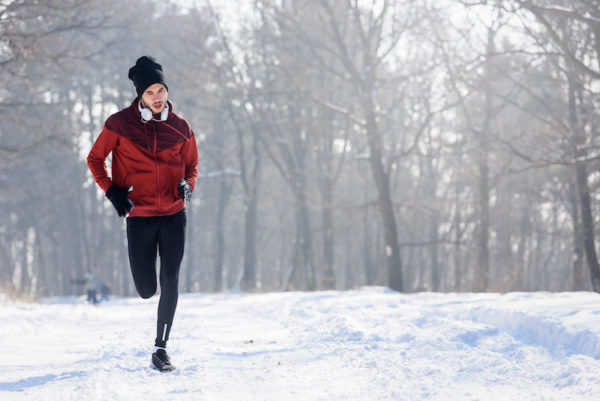What serious runner ever let a little snow slow them down? The thing is, you need to pay attention because snow and winter conditions can cause problems.
The lower temperatures can wreak havoc on a runner’s muscles, especially transitioning quickly from a warm indoor temperature to freezing ones outside. Additionally, the snow and ice accumulations can put runners at risk for injury.
Knowing how to combat these challenges can help you extend your running season all throughout winter, injury-free!
Here are a few tips and guidelines to follow when running in winter conditions:
Dress Appropriately
When you first transition from warm indoor temperatures to colder outside ones, the shift can be a shock to your body. Be sure to layer up so that at the beginning of your run, while your body is cool, you stay warm. Then you have the option to remove layers as you warm up with your run.
Be sure to choose moisture-wicking clothing, such as polyester blend or light wool. Clothing made of cotton may feel nice at first, but as it gets wet from snow and sweat, it will not dry and the damp, cold fabric will only make your body feel colder. The same applies to your socks!
Footwear
Depending on the conditions, you may have a few different options for footwear. If the roads are bare, you can probably get away with your regular running shoes. You may want to opt for a trail shoe, which provides a little bit better traction on roads with a little bit of snow.
If the snow and ice are providing for slippery surfaces, look for a shoe stabilizer that goes on over your running shoes to provide a little more grip to the ground. You can also make your own winter running shoes by inserting screws into the bottom of your shoe. Be sure to consult with a professional shoe fitter to find the best option for you.
If running conditions are particularly sloshy, you may want to invest in a pair of gaiters for yourself. These water-repellent covers attach to your shoe and extend up and around your shin, over your running clothing. In snowy, wet conditions these can be a lifesaver as they repel the water that splashes up at your legs while you run.
Warm-Up
A thorough warm-up is important to every run, but maybe even more so in the winter. You can’t expect to be able to stand up from your desk or couch where you’ve been in warm indoor conditions and easily transition out into the cold.
Try doing something as simple as some jumping jacks, light push-ups, or running in place – anything to get your heart elevated. You should also consider doing some dynamic stretching to get your muscles loose and warmed up before you head out.
And, don’t expect to step out the door and begin running at your fastest pace. Allow your body to ease into your run and make that temperature transition an easier one.
Safety
The biggest safety concern in the winter is visibility. With shorter days and less sunlight, those who run before or after work are probably going to encounter some darkness on their run. It’s critically important to be equipped with the right safety gear to make sure you are visible to motorists and other people.
There are many different options for reflective gear, between vests and straps to clothing that has reflective fabrics built into them. The more reflective materials and lights on your body, the better. You should also consider a headlamp. Not only does this help those approaching you to see you, but it will also help you to see the road before you and keep safe footing.
Cool-Down
Cooling down after your run is really important, especially as you transition back into warmer indoor temperatures. Try doing some light stretching or perhaps some soft tissue work, such as stretching with a foam roller. It’s important to ease your body back into its resting heart rate state.
Also, don’t forget about hydration! Runners tend to forget about hydration in winter running, as you may not feel as thirsty as you do after a hot, summer run, but hydrating after winter runs is just important. Your body can lose just as much fluid as it does in the summer.
Go, Run!
So get on out there and give winter running a try. Investigate your local tracks to see if they keep the snow cleared off or look into trails in your area. Oftentimes, snowmobiles keep the snow packed down enough on trails that you can run on them, though they may be a little slippery and as always, make sure you are very visible.
Roads also make a great option for winter running. Just keep in mind your safety tips and when the snowbanks become so high you can’t see around them or they impede on a safe running space, take your run indoors. Not everyone loves a treadmill run, but your safety is what’s most important.
Happy Running!



Leave A Comment